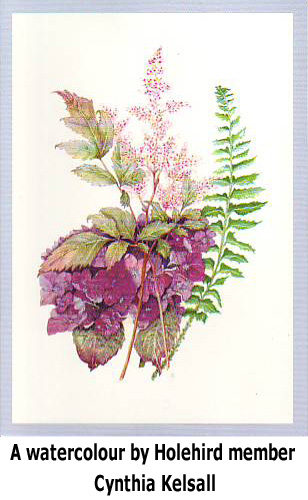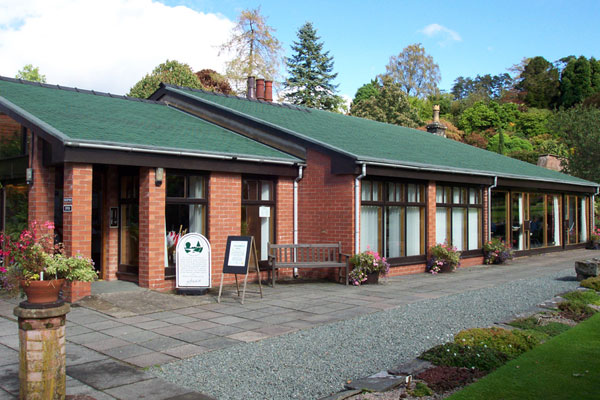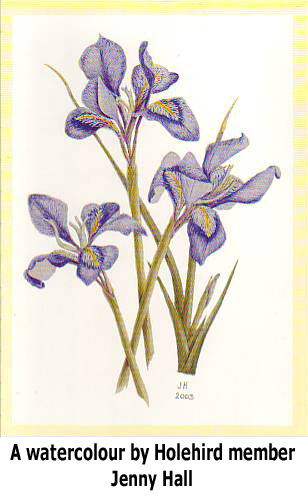
Visited on September 19, 2007
While looking through the internet link my daughter had sent me for vacation planning I found Holehird gardens under “Blooms with a View.” What caught my attention was the fact that the 10-acre garden on a mountainside is maintained by volunteers.
Wednesday was the day indicated to visit if you wanted to chat with the gardeners. As a member of Virginia Master Gardener Association, the volunteer work resonated with me. This was a Wednesday destination regardless of the weather. We were fortunate for a most beautiful day in the Lake District.
We took the train from Manchester to Windermere. We found that there was no bus transportation to the garden. Being walkers on this trip, we bypassed a taxi ride and took a hard walk up the mountainside.
Once arriving at the gardens, it is worth it to purchase their full color garden booklet at the reception building. It will give you directions for routes to walk with description of the beds along the paths. It will also indicate which paths are suitable for people who have the need to use a wheelchair or may have other disabilities that restrict their mobility.
In retrospect, I consider this mountainside visit the highlight of my garden interest tour in England and am looking forward to a return trip. A visit to Holehird would be an inspiration to any volunteer gardening group, organization, or even the home gardener who is fortunate enough to visit this lovely area of the United Kingdom.
In this report I would like to focus on the organization of the Lakeland Horticulture Society (LHS) and let the photos Dave took of the gardens and mountain-view fill in the visual impressions of our visit. Francis Davenport, a member from Kendal, was very helpful in replying to my lengthy e-mails of questions to obtain additional information for this write up.
History
“Hole Herd” was a hillside sheep farm at the southern end of Troutbeck valley near Windermere. It was purchased in 1845 by John Lingard. He built the first part of a Gothic style villa and the beginning of gardens overlooking Windermere Lake. The next owner continued to expand the villa, adding a conservatory to the house, a landscaped formal garden, and a walled kitchen garden. Victorian gardens, heated greenhouses, and vineries were also added at about this time. The property again changed ownership in 1897 to William Groves. Groves designed a rock garden, created water features, and planted trees. The greenhouses were enlarged to accommodate his orchids. He also sponsored plant-hunting expeditions to northwest China.
The mansion, gardens, and farm were gifted in trust in 1945 by Henry Groves (son of William) to the Westmorland County Council with specific instructions that the estate was to be used for people in need of special care. The trust was not able to financially maintain the gardens that had been passed down thru ownership since 1845. Greenhouses deteriorated and the grounds reverted back to nature with only the lawn and borders in front of the manor house maintained. The mansion was occupied in 1961 as a residential home for physically disabled adults, as it was felt that this unique setting would contribute to their well-being. The charity, Holehird Trust, was established in 1962 to administer that estate.
In 1969 the LHS was formed with 200 members with the intention to restore the gardens. In 1971 they leased from the trust two acres of the abandoned rock garden behind Holehird mansion. It took several years to clear the area behind the mansion, make new beds, create paths, and clear the slope of the Upper Garden. The Walled Garden, which they took over in 1979, was cleared and became the site for the members accommodation and reception building.
Over the next two decades the LHS leased additional areas from the Holehird Trust and continued to refurbish the gardens in stages. The lower garden was acquired in 2001, when the gardener employed by the landlord retired. That acquisition completed the reuniting of the original 19th century garden. In 2002, Holehird was featured on BBC Gardeners’ World as ‘one of the nation’s favorite gardens.’ In 2009 the society acquired an additional seven acres when they took on the responsibility of maintaining the tarn that William Groves created near the mansion house.
Philosophy of the Lakeland Horticulture Society
The Lakeland Horticulture Society, a Registered Charity, was formed to promote “the science, practice and art of horticulture in Cumbria.” The society was based at Holehird, having taken on the challenge of restoring the gardens. The aim of the society was to “stimulate interest in horticulture and to demonstrate the diversity of plant genera which succeed in the prevailing soil and weather conditions in the English Lake District.” Holehird is unique in England, being an open garden to the public that is maintained by volunteers and funded solely by donations.
Organizational Structure
A council of trustees manages and controls all the affairs of the society. These council trustees are members of the society that are nominated and seconded by other members. They serve for 3 years with an option to serve for an additional three years only. There are six sub-committees who answer to the Council: Garden, Education, Publications, Public Relations, House and Finance, and General Purposes. Each of these six are headed by a chairperson who is required to be a member of the Council. There are 5 officers: Chairman, Vice Chairman, Treasurer, Secretary, and Garden Co-ordinator. These officers have to seek re-election every year.
Membership
According to their current website, the LHS have approximately 1800 yearly dues-paying members from all parts of the country, with around 250 active members. Due to the increase of membership and volunteer workers over the years, the LHS was able to expand the gardens to its current 17 acres. Membership to Holehird Gardens is open to any person who is interested in horticulture and wants to support this unique garden.
Members are equal when they join, regardless of their horticulture experience or education. Francis noted that, “position and respect, and therefore the right to influence comes entirely from the proven work within the society and not from previous history.” If a new member is interested in working in the gardens, they are placed with an experienced member, according to their interest, and are “gently” assessed for how or where they will fit in.
Educational training is available with a linked course with Newton Rigg Campus, University of Cumbria, but is not required. Many new members join when they retire as retirement provides the time to research different areas and develop skills.
Membership Benefits
Membership allows participation in the “horticulture, educational and social life of the society.” Members have access to a well-stocked reference and lending library at the members accommodation building. Twice a year the society publishes a journal containing articles written by professional horticulturists. Three newsletters are sent out during the year informing members of courses, talks, garden visits, and social events. New members are invited to a New Members meeting at the garden to orientate them to the garden and learn how the society is maintained and managed.
Membership Education, Activities and Training
Educational events for members range from courses on digital photography of flower images to botanical painting. Members’ mini-lectures are held once a week from spring thru fall covering topics such as landscapes, specific plants, and medicinal plants. There is a thriving propagation team who like the challenge to grow all sorts of plants. Propagation training sessions are provided from seed starting to grafting. She stated that the alpine team recently offered rare Daphne plants as well as varieties of Saxifrages for propagation. Many of the plants provided at their annual sale result from the contributions of this team.
For members that may not be able to help physically maintain the gardens due to job commitments, distance, or other reasons, there are other ways to contribute. Members take the responsibility of maintaining their IT systems and websites, produce the bi-annual journal, newsletters and garden leaflets. Booking garden visits and giving lectures and slide shows are other opportunities for members to be involved. Currently, the extensive archive of data and photographs that have been maintained are being digitalized by volunteers. The reception building is also manned by volunteers.
Membership Educational Fun
In recent years the LHS have had holidays booked as a group visiting Sweden for a week titled ”In the Footsteps of Linnaeus.” Sicily and Andalucia are also listed as past trips.
Closer to home was a trip to Charles Jenks garden of Cosmic Speculation in Dumfries. Past trips include the Royal Horticulture Society gardens at Harlow Carr and Rosemoor, and the Eden Project, a biome conservatory containing plants from rainforests and warm temperature regions. Highgrove estate, where Prince Charles promotes his interest in organic farming and gardening, was another membership trip.
Northeast and Northwest Scotland have also been a popular destination for LHS group trips.
Public Education
The LHS is an educational charity and opens its lectures to the public. Most are free of charge, although some are charged because the speaker is provided by the Royal Horticultural Society. The listing of speakers and titles is available on the LHS website.
Members also provide garden tours for the public. Accredited university courses through Newton Rigg Campus are offered at the Holehird facility for members and nonmembers.
The National Collections
Holehird Gardens is home to three National collections thru designation of the National Council for the Conservation of Plants and Gardens (NCCPG). Annual reports are required. Records are maintained with photographs, as well as dried specimens and descriptions. The plants are looked after carefully and labeled. Holehird’s designated collections are ASTILBE, HYDRANGEA, AND POLYSTICHUM FERNS.
ASTILBE, HYDRANGEA, AND POLYSTICHUM FERNS
They have a collection of over 200 species and cultivars of Hydrangea with bloom time from July to October. In mid September, during our visit, there was a mix of some Hydrangea still with full colors and others waning.
The Astilbe collection started in 1987 with 38 donated plants. The collection has grown (as of 2007) to 20 species and 180 cultivars that bloom in mid July thru early August.
The fern collection was started in 1987 with 27 named specimens. As of 2007 the collection had grown to some 60 cultivars as well as 9 foreign species.
Holehird Gardens was awarded Scientific status by the NCCPG for the Astilbe Collection in 2000 and the Hydrangea collection in 2006.
Volunteer Shelagh Newman, who has researched and maintained the National Collection of Hydrangea, has represented the Society in a lecture given in Italy and collected seeds of wild hydrangea and rhododendron plants in China. The seeds she collected have been sent to the American Rhododendron Society and the Royal Horticultural Society for distribution.
Trial Gardens
A ongoing trial of David Austin Roses has been conducted since 2001 by John Davenport to test the traditional view that roses do not do well in the Lake District. A micorrhizal fungal mixture was used in this test. Other than deer and rabbit damage, they state that roses can be grown in the Lake District. The LHS has also been involved in formal trials of poppies, delphinium, agapanthus, and asters to name a few for the ‘Gardening Which?’ magazine.
Growing Conditions
Holehird Gardens could be called a trial area in itself, as one of the purposes of the Society is to determine which plants grow well in Lakeland conditions. The gardens are situated on a west-facing slope 500 feet above sea level, with the Irish sea about 10 miles away. The climate is cool and moist. Summer air temperatures are not high. Winter frost is uncommon. Due to its sloping nature, there are few frost pockets. If an early autumn or late spring frost occurs, it can be devastating.
The average rainfall is 69-70 inches per year causing nutrients to be leached from the soil. Thus organic materials and mulches are frequently needed. April, May, and June are fairly dry and sunny. August thru the winter months are the wettest. The rainy, overcast weather limits the amount of sunshine. An automatic weather station has been installed recently to record the main climate factors that affect plant growth.
The soil is thin and of poor quality due to glaciation. It is well drained due to being stony and situated on a sloping site. Natural rock gardens are on Coniston Grit outcrops which are 400 million years old. The soils are acidic with a pH 5 to 6, ideal for the acid-loving plants that are abundant in the garden. In the Walled Gardens the soil is deep and rich due to a century of cultivation, so a wide range of plants are grown in that area.
Maintaining the Gardens
The garden is divided into working units cared for by an individual or team. There is a mowing and edging team. On Tuesday the “heavy gang” works on jobs such as stump removal, maintaining the roads and pathways, and gravel moving. Large scree beds and the alpine house are cared for by the alpine team. Engraved plant labels are produced by a labeling team. Approximately 50 gardeners join to weed, plant, and do other garden chores (in winter time a few less).
Apparently the team concept is somewhat informal. Members are free to work at Holehird whatever day and time suits them, as the grounds are never closed.
On the Wednesday I was there the members were assembling over the noon hour for lunch and a meeting in the members accommodation building.
Francis said she helped in several areas when she first joined the group. When the individual who had planted the roses since the start of Holehird passed on, she was put in charge of the roses, as she had shown an interest in them. She said that she has continued to retain the character of the original bed and has added a lot of the species roses that are best for the clean air and wet conditions there. She also maintained the grass beds when we were visiting and at that time was putting in new plants. The grass beds and plantings were her initiative. The initial idea had to be brought before the Garden committee. Money, manpower, and resources had to be approved to develop the new beds.
Facilities
The CONTEMPORARY MEMBERS ACCOMMODATION AND RECEPTION BUILDING 
ACCOMMODATION AND RECEPTION BUILDING is used as a visitor centre as well as for members use. Wardens are on duty every day from Easter to October to welcome and assist visitors from 11 a.m. to 5 p.m.
The “pit” greenhouses were two original structures from the Victorian era that have been refurbished. They were built into the hillside for heating and cooling purposes. The Tufa house, pre-1906, has built-in rocks and waterfall features.
The “Lane” greenhouse was built in the early 1900’s by William Groves. Local stone was used in the construction with two walls below ground level. It has been refurbished.
The Hartley House was built in 2000 and is used for the display of alpines. Recently a new heated green house has replaced a polytunnel.
The hardy perennial team, alpine team, and half-hardy team each have their own greenhouse. There are a lot of frames and a polytunnel for other plants.
Fund Raising
Visiting the garden is free for the public, but donations are welcome at the reception house. Plants from the Holehird garden are available for purchase during the growing season. Visitors’ donations and plant sales help the organization maintain and develop the gardens.
The membership list of Holehird Gardens has many participants who are artists in various mediums. I purchased CHRISTMAS CARDS
designed from a member‘s photograph of winter scenes at Holehird. A package of note cards I purchased were based on WATERCOLORS OF THE FLOWERS OF HOLEHIRD
done by several artists.
Reflections
I did find many similarities between the Lakeland Horticulture Society and the Master Gardener Association in the States, which is also a volunteer organization. Both organizations provide horticulture education, hands-on experience, and lecture/classes to their members. They both outreach to the public to provide educational information. Speakers and volunteers are available to answer gardening questions.
The Tidewater, VA area is dryer with more sunshine than the Lake District, but allows the growth of many of the same varieties of plants. Other areas of the US have similar weather and soil conditions as the Lake District and it may benefit those master gardeners to learn from the Holehird experience. We all seem to have complaints of deer, rabbits, and other varmints that can destroy our gardens – devouring our plants, vegetables and fruit trees overnight.
We all enjoy the camaraderie of traveling together to visit places of mutual interest. Fund raising projects not only raises money put provides a common goal for the group.
After reflecting on that afternoon I spent haphazardly roaming the grounds of Holehird and meeting several people there, I feel that any differences between the two organizations are insignificant. Gardeners on both sides of the Atlantic join their respective groups to contribute their skills and enthusiasm to an activity that enriches the world.
Visit this site at: www.holehirdgardens.org.uk